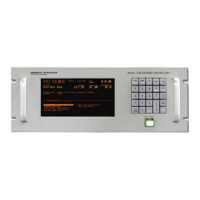Theory
3.1.2 Orbit Determination
An orbital element set is composed by making an initial guess of the orbit and then
generating positions from this guess using the propagators described previously.
These positions are compared with the positions gathered by AST. The differences
between AST data and propagator-generated data are used to determine a
correction to the orbit. The process is repeated until the RMS error between the
AST data and the propagator-generated data is minimized. The algorithm used to
perform this is referred to as the solver.
The orbit must be periodically re-solved in order to remain accurate. Theoretically,
if all of the forces acting upon the spacecraft are known at any time, the orbital
element set can be predicted forward to any desired time. However, all of the
forces are not known at all times. The largest unknown force comes from the
station-keeping maneuvers performed in order to keep the spacecraft in the desired
orbit. Station-keeping is only performed periodically (typically once every few
days). The validity of an orbit solution determined from data after a maneuver has
taken place is not adversely affected by station-keeping until a new station-keeping
maneuver is performed.
The two-body propagator does not take into account any forces except those
generated by the Earth's gravity, and even then, a simplified model is used. A
position prediction from a two-body propagator has an error that grows with time
due to the omission of these forces in the orbit determination.
Neither propagator can account for varying effects on the ground. The primary
ground errors affecting the system are:
• Wind loading of the antenna.
• Thermal distortion of the antenna, caused by non-uniform solar heating.
Both of these factors affect the data collected by AST. However, OPT is able to
separate ground errors from the orbital solution because the spacecraft's motion
must follow Newton's laws. This information is retained as two error terms, one
per axis. These error terms are used to correct future position predictions.
3.1.2.1 Short-term and Long-term OPT Solutions
OPT generates three distinct types of orbital solutions:
• Short-term solution using two-body propagator (ST)
• Long-term solution using two-body propagator (LT2b)
• Long-term solution using multibody propagator (LTmb)
3-2

